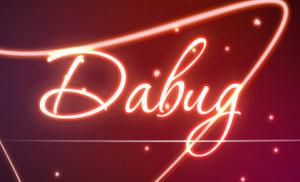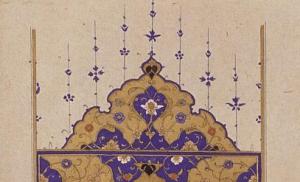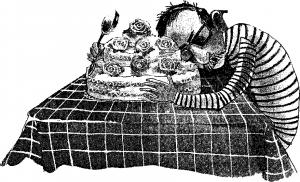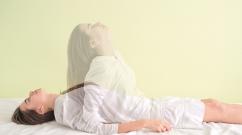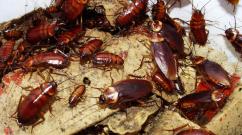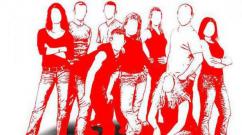How to form the plural of nouns in German. Plural in German
Step 17 – Plural in German– how is it formed?
Rule 1.Plural also has its own article - die. Same article as feminine.
Rule 2. Most German words, especially feminine words, are pluralized using the ending –en:
die Übung – dieÜbung en
die Möglichkeit – die Möglichkeit en
There are words in which nothing is added:
der Sessel – die Sessel (chair – chairs)
das Brötchen – die Brötchen (bun - buns); words to –chen, -leindo not change
There is a group of words in which the plural words end in –er or -e , and the vowel at the root of the word also changes.
das Kind – die Kind er(child - children)
das Buch – die Buch er(book - books)
der Mann – die Mann er (man - men)
der Stuhl – die St ü
hl e(chair - chairs)
die Hand – die H ä
nd e(hand - hands)
der Schrank – die Schr ä
nk e(wardrobe - cabinets)
die Wand – die W ä
nd e(wall - walls)
There are words that in the plural end in –s .
das Taxi – die Taxis (taxi – taxi)
das Radio – die Radios (radio – radio)
der PKW – die PKWs (passenger car - passenger cars)
der Job – die Jobs (work - work)
The following words just need to be remembered:
das Museum – die Museen (museum – museums)
das Datum – die Daten (date – dates)
das Visum – die Visa (visa – visas)
das Praktikum – die Praktika (practice - practices)
die Praxis – die Praxen (reception - reception)
das Konto – die Konten (account – accounts)
die Firma – die Firmen (firm – firms)
Good news
There is a large group of words that are used only in the singular. Here are the main groups of such words:
1. collective words (items that cannot be counted)
2. abstract words
3. units of measurement, as well as the word das Geld- money
| 5 Kilo Orange | 1 kg oranges | 2 Liter Wasser | two liters of water |
| 2 Glas Bier | 2 beers | 100 Gramm Fleisch | one hundred grams of meat |
| 100 Euro | 100 euros | eine Tube Zahnpasta | one tube of toothpaste |
Plurals in German are difficult to formulate into one rule. Too many options, too many exceptions. But two points can be remembered:
- Words on –e always get –en in the plural.
- Feminine words ending in –schaft, -keit, -heit, -ion also receive –en at the end. Most words have this ending.
It makes sense to memorize the remaining words with the help of exercises.
To speak German fluently, you do not need to know the plural of absolutely all words - this information increases as the words are most often used in speech in the plural. Words in the plural are used less often than in the singular.
When I was at school and then at university, German teachers always insisted on learning all words in the singular and plural. More often than not, this turned out to be unnecessary information that was quickly forgotten. In order to learn a language quickly, it is important to remember only relevant information. For example, learn the plural of the most common words first, and learn the rest later, as you use them.
Exercises for plurals in German:
There is another interactive exercise.
Do you have any questions about this topic? Write in the comments.
Lesson 17: How to form plurals in German was last modified: November 1st, 2018 by Catherine
In German, as in Russian, a noun (noun) has 2 numbers (numerals): singular num. (der Singular) and plural (plural) numbers. (der Plural).
For the education of many number The following means are used in German:
1. Suffixes –e, –en, -er, -s:
der Tisch – die Tische (table-tables)
die Zeitung – die Zeitungen (newspapers)
das Bild- die Bilder (picture-paintings)
der Klub- die Klubs (club-clubs)
2. Umlaut:
der Sohn- die Söhne (son-sons)
der Vater – die Väter (father-fathers)
3. Article:
der Orden - die Orden (order-order)
der Wagen – die Wagen (car-cars)
In most cases, these means are combined, for example: das Kind- die Kinder (child - children); das Buch- die Bücher (book- books).
There are five types of plural formation in the German language. number depending on plural suffixes.
For each type of education there are many. number include nouns. of one kind or another.
I type of plural formation
A characteristic feature of type I is the suffix -e. According to this type they form plural. number:
1) Most names are nouns. masculine:
a)der Berg(mountain)- die Berge
der Pilz (mushroom) - die Pilze
der Preis (price) - die Preise
der Pelz (fur coat) - die Pelze
der Ring (ring) - die Ringe
der Krieg (war) - die Kriege
der Tisch (table) – die Tische
der Hof(yard)- die Höfe
der Kopf (head) - die Köpfe
der Kampf (struggle) - die Kämpfe
der Raum (room) – die Räume
der Stuhl (chair) – die Stühle, etc.
b) der General (general) – die Generale
der Offizier (officer) – die Offziere
der Ingenieur (engineer) – die Ingenieure
der Pionier (pioneer) - die Pioniere, etc.
2) some nouns. neuter:
a) das Beispiel (example) – die Beispiele
das Heft (notebook) – die Hefte
das Bein (leg) – die Beine
das Ereignis(event)- die Ereignisse
b)das Diktat (dictation) – die Diktate
das Dokument (document) – die Dokumente
das Lineal (ruler) –die Lineale
das Objekt (addition) – die Objekte
das Resultat (result) – die Resultate
das Substantiv (noun) - die Substantive
3) a group of monosyllabic nouns. feminine:
die Bank (bench) - die Bänke
die Frucht (fruit) - die Früchte
die Gans (goose) - die Gänse
die Kraft (strength) – die Krafte
die Kuh (cow) - die Kühe
die Macht (strength) – die Mächte
die Maus (mouse) - die Mäuse
die Nuss (walnut) – die Nüsse
die Stadt (city) – die Städte
die Wand (wall) – die Wände, etc.
II type of plural formation
A characteristic feature of type II is the suffix –(e)n. According to this type they form plural. number:
1. all polysyllabic and most monosyllabic nouns. feminine:
a)die Tafel (board) – die Tafeln
die Klasse (class) – die Klassen
die Tür (door) – die Türen
die Lehrerin (teacher) – die Lehrerinnen
b) die Fakultät (faculty) – die Fakultäten
die Revolution (revolution) – die Revolutionen, etc.
2. Some nouns. masculine:
a) ending in –e:
der Junge (boy) – die Jungen
der Russe (Russian) - die Russen
der Name (name) – die Namen
der Buchstabe (letter) – die Buchstaben
b) the following words:
der Held (hero) - die Helden
der Mensch (person) – die Menschen, etc.,
der Nachbar (neighbor) – die Nachbarn
der Staat (state) – die Staaten
der Vetter (cousin) – die Vettern
c) words with foreign suffixes –at, -ant, –et, – ent, -ist, etc. (with emphasis on the suffix, usually denoting male persons)
der Soldat (soldier) – die Soldaten
der Aspirant (graduate student) – die Aspiranten
der Prolet (proletarian) – die Proleten
der Student (student) –die Studenten
der Kommunist (communist) – die Kommunisten, etc.
3. Group of nouns. neuter:
das Auge (eye) – die Augen
das Ohr (ear) – die Ohren
das Bett (bed) – die Betten
das Ende (end) – die Enden
das Hemd (end) – die Hemden
das Interesse (interest) – die Interessen
das Herz (heart) – die Herzen
das Insekt (insect) – die Insekten
III type of plural formation
A characteristic feature of type III is the suffix –er. According to this type they form plural. number:
1. Most names are nouns. neuter:
das Bild (picture) – die Bilder
das Brett (board) – die Bretter
das Kleid (dress) – die Kleider
das Lied (song) - die Lieder and others.
das Buch (book)– die Bücher
das Fach (item)- die Fächer
das Dach (roof) - die Dächer
das Haus (house) – die Häuser
das Volk (people) - die Völker and others.
2. Small group of nouns. masculine:
der Mann (man) – die Männer
der Rand (edge) – die Ränder
der Wald (forest) – die Wälder
der Mund (mouth) - die Münder, etc.
IV type of plural formation
Characteristic sign: no suffix, no umlaut and with umlaut of the root vowel. According to this type they form plural. number:
1. All names are nouns. masculine in –er, -el, en:
der Lehrer (teacher)-die Lehrer
der Schüler (student) - die Schüler
der Onkel (uncle) – die Onkel
der Bruder (brother) – die Brüder
der Mantel (coat) - die Mäntel
der Garten (garden) - die Gärten
der Hafen (harbour) – die Häfen, etc.
2. All names are nouns. neuter:
a) on – er, -el, -en:
das Banner (banner) – die Banner
das Fenster (window) – die Fenster
das Messer (knife) – die Messer
das Zeichen (sign) - die Zeichen, etc.
b) with suffixes – chen, – lein:
das Stühlchen (high chair) – die Stühlchen
das Tischlein (table) – die Tischlein, etc.
c) with the prefix -Ge and suffix –e:
das Gebäude (building) – die Gebäude
das Gebirge (mountains) – die Gebirge, etc.
2. two nouns. feminine:
die Mutter (mother) – die Mütter
die Tochter (daughter) – die Tochter
V type of plural formation
A characteristic feature of type V is the ending –s. According to this type they form plural. number:
1. nouns masculine and neuter, borrowed mainly from English and French:
masculine
der Klub (club)– die Klubs
der Chef (chief, chief) – die Chefs
neuter
das Auto (car) – die Autos
das Café (cafe) – die Cafés
das Hotel (hotel) – die Hotels
das Kino (cinema) – die Kinos
das Sofa (sofa) – die Sofas
2. suffix is added to compound words:
der VEB (people's enterprise) – die VEBs
die LPG (agricultural production cooperative) – die LPGs
3. personal names when they indicate a title the whole family or several persons bearing the same first or last name:
die Millers (Miller family)
Special cases of plural formation. number noun names:
Masculine:
der Bus (bus) – die Busse
der Typ (type) – die Typen
der Kursus (course) – die Kurse
Neuter:
das Museum (museum) – die Museen
das Prinzip (principle) – die Prinzipien
das Thema (theme) – die Themen
das Stadion (stadium) – die Stadien
das Drama (drama) – die Dramen
das Datum(date) – die Daten
das Verb (verb) – die Verben
das Auditorium (audience) – die Auditotorien
das Laborarium (laboratory) – die Laboratorien
das Studium (lesson) – die Studien
Plural expression number using word-forming means:
der Seemann – die Seeleute
der Bergmann – die Bergleute
der Kaufmann – die Kaufleute, etc.
der Rat – die Ratschläge
der Mord – die Mordtaten
The plural of nouns in German can be formed in different ways.
1. Some neuter and masculine nouns ending in a consonant create a plural by adding the suffix -er, while the front vowel often becomes umlaut (a-ä, o-ö, u-ü), for example:
das Kind, der Strauch, das Buch, der Wald, das Haus - die Kinder, die Sträucher, die Bücher, die Wälder, die Häuser.
2. For masculine nouns ending in -el, -(e)n, -(e)r, no suffixes appear when forming the plural, but in many cases vowels also turn into umlaut, for example:
for the nouns der Vogel, der Garten, der Bruder, der Vater, der Wagen plural respectively: dieVögel, die Gärten, die Brüder, die Väter, die Wagen.
For neuter nouns ending in -er, -en, -el, -lein, -chen, with the suffix -e and the prefix ge-, only the article changes when creating the plural:
das Mädchen, das Mittel, das Fenster, das Gebäude, das Fräulein become die Mädchen, die Mittel, die Fenster, die Gebäude, die Fräulein.
In German, like in Russian, there are words that are used only in the singular. These are nouns denoting substances (das Eisen, das Gold, das Silber, das Leder), abstract concepts (die Liebe, der Stolz), some collective (das Publikum, die Studentenschaft), however, in Russian these nouns exist only in the singular number. But in German there are nouns that are used in the singular, and in Russian only in the plural (die Brille (glasses) is singular, die Brillen (glasses) is plural). Masculine and neuter nouns denoting quantity and size, if preceded by a cardinal numeral, are always singular (zwei Glas Wasser), feminine nouns are always plural (zwei Flaschen Bier).
In German, as in Russian, there are several words that are used only in the plural:
die Eltern - parents
die Ferien - holidays
die Mobel - furniture
die Trümer - ruins
With such words everything is clear, they are even in the plural in the dictionary and they never had a singular number.
When forming the plural from singular nouns, the following can happen:
- adding an ending to a noun (-e, -en, er, s)
- adding an umlaut to the root vowel (a->ä, u->ü, o-> ö)
- changing the entire word
It is worth saying and emphasizing that
Most masculine plural nouns add the ending -e (der Fisch - die Fisch e), often receiving the umlaut of the root vowel;
feminine - ending -(e)n (die Frau - die Frau en) or -nen if the word ends in -in (die Lehrerin - die Lehrerinnen);
neuter - ending -er and always with an umlaut at the root, if possible (das Kind - die Kind er, das Buch - die Bücher, das Land - die Länder).
But you shouldn't rely on this. This is not a rule, it's just a sign. The plural of nouns must be memorized, just like the gender.
As you noticed, nouns are plural, regardless of gender definite article always the same die. Indefinite article there is no plural, in this case the word is used without an article (Kinder - children in general, die Kinder - some specific children)
End -e Most masculine nouns are pluralized, often receiving an umlaut ( der Tag - die Tage, der Kopf - die Köpfe, der Schrank - die Schränke). Masculine nouns formed from verbal roots always receive an umlaut ( der Klang - die Klänge, der Fall - die Fälle).
There are not many feminine nouns that add -e to the plural. They need to be remembered ( die Stadt - die Städte,die Hand - die Hände, die Wand - die Wände, die Kunst - die Künste, die Wurst - die Würste,die Kraft - die Krafte, die Maus - die Mäuse, die Kuh - die Kühe, die Nuß - die Nüße, die Bank - die Bänke, die Macht - die Mächte,). They always accept the umlaut.
Nouns ending in -nis always form the plural by adding -se regardless of gender .
Also, many neuter nouns end in -e in the plural ( das Jahr - die Jahre, das Heft - die Hefte, das Pferd - die Pferde, das Werk - die Werke), but they are always without an umlaut. These nouns also include neuter nouns of Latin origin, often ending in -at, al, ent (das Diplom - die Diplom e, das Element - die Elemente, das Signal - die Signale, das Modell - die Modell e das Plakat - die Plakate). They can be recognized by the fact that they sound approximately the same in many languages.
Most feminine nouns add - (e)n . (die Schule - die Schulen, die Regel - die Regeln, die Zeitung - die Zeitungen). For feminine nouns ending in -in, in the plural, another -n is added before -en ( die Studentin — die Studentin nen, die Lehrerin - die Lehrerinnen,).
Most nouns ending in -e, plural adds -n (der Jung e— die Jung en ). These words include many feminine words, many masculine words called weak nouns, and some neuter words ( das Auge - die Augen, das Interesse - Interessen, exception das Knie - die Knie). The ending en is also given to the names of masculine animate objects that have lost the suffix. -e (der Mensch - die Mensch en ) (again, these nouns are also weak). Weak nouns also include borrowed animate masculine nouns ending in -ant, -ent, -at, -ist, -nom, soph, log(e), -graph, having stress on the last syllable and denoting profession, occupation, etc. They all have plural endings too -en (der Aspirant, der Student, der Kandidat, der Kommunist, der Agronom, der Philosopher, der Geolog(e), der Photograph - die Photographen).
End -en Some strong masculine nouns also receive the plural (der Schmerz - die Schmerz en, der Staat - die Staat en, der Nerv — die Nerv en,Der Strahl - die Strahlen ), borrowed with the suffix -or (der Professor - die Professoren, der Doktor - die Doktoren), borrowed with double suffix -ismus(is+mus) ( der Mechanismus - die Mechanismen)
Also ending -en Some neuter nouns receive a suffix ( das Bett - die Betten, das Ohr - die Ohren, das Hemd - die Hemden, das Insekt - die Insekten) and borrowed nouns ending in a suffix -um , which replace this suffix -um with -en in the plural ( das Auditorium - die Auditorien,das Museum - die Museen, das Album - die Alben,das Datum - die Daten). Other suffixes in neuter nouns also change to -en in the plural ( das Virus - die Viren,das Stadion - die Stadien, das Drama - die Dramen)
Most very common neuter words get plural -er (das Buch - die Bücher, das Lied - die Lieder, das Kind - die Kinder, das Land - die Länder) and umlaut root vowel. Masculine and neuter words ending in -tum add -er in the plural and -tum changes to -tum (der Irrtum - die Irrtümer, der Reichtum - die Reichtümer, das Herzogtum - die Herzogtümer).
There are several monosyllabic masculine nouns without endings that take the plural form -er and umlaut ( der Wald - die Walder,der Mann - die Männer,der Rand - die Ränder, der Gott - die Götter, der Geist - die Geister). Feminine plural nouns never end in -er.
Nouns that come from English or French, retain their native ending -s (der Park - die Parks, der Clown - die Clowns, das Büro - die Büros), but sometimes when words begin to “Germanize” the endings become German ( der Bus - die Busse, die Bank - die Banken).
End -s German words ending in a vowel except -e ( der Opa - die Opa s, die Oma - die Oma s, der Uhu - die Uhu s ), various abbreviations ( die Ags(Aktiengesellschaft)) and family names ( die Müllers(Müller Family))
Masculine words ending in -en, -er, el they do not undergo any changes in the plural, since they already initially have a plural suffix ( der Fahrer - die Fahrer, der Wagen - die Wagen,der Schlüssell - die Schlüssell, der Lehrer - die Lehrer,Butder Bayer - die Bayern, der Pantoffel - die Pantoffeln, der Muskel - die Muskeln, der Stachel - die Stacheln), but sometimes an umlaut appears ( der Hafen - die Häfen, der Bruder - die Brüder). Neuter nouns with the same suffixes and with diminutive suffixes also do not undergo changes. -chen, -lein, but they never get umlyut in this case ( das Mädchen — die Mädchen, das Tischlein - die Tischlein). Also, neuter nouns that have the prefix ge- and the ending -e (das Gebirge - die Gebirge) do not change.
Feminine words ending with suffixes -er or -el, in the plural the ending is added -n (die Schwester - die Schwester n, die Kartoffel - die Kartoffel n , die Mutter —die Muttern(nut-nuts)), but there are a couple of exceptions ( die Mutter - die Mütter, die Tochter - die Tochter)
Some plural nouns change completely. Such nouns include words with the suffix -mann, which in the plural is converted to leute (der Seeman - die Seeleute, der Landmann - die Landleute, der Kaufmann - die Kaufleute, der Bergmann - die Bergleute). But when talking about individuals, especially if they are male, -mann in the plural becomes männer. (der Staatsman - die Staatsmänner, der Kaufmann - die Kaufmänner)
Words that are used in two versions: in the abbreviated and in the unabridged plural, only the unabridged version is used (der Rat (der Ratschlag) - die Ratschläge, der Regen - die Regensfälle, der Stock (der Stockwerk) - die Stockwerke, das Unglück - die Unglücksfälle, der Mord - die Mordtaten)
It is worth paying attention to the fact that some words that are pronounced the same, but have different genders, can have different endings in the plural:
der Bauer (peasant) - die Bauern (peasants), das Bauer (cell) - die Bauer (cells)
der Tor (fool) - die Toren, das Tor (one gate) - die Tore (many gates)
Two words that are spelled exactly the same in the singular and have the same gender, but denote different things (homonyms), can form the plural differently:
die Bank (bench) - die Bänke (benches), die Bank (bank) - die Banken (banks)
die Mutter (mother) - die Mütter (mother) - die Mutter (nut) - die Mutttern (nuts)
das Wort (word) - die Worte (words, coherent speech) - die Wörter (individual words)
German nouns can either form the plural or be used only in the singular or only in the plural.
Nouns that are used only in the singular include real and many abstract nouns: die Milch (milk), das Fleisch (meat), die Kälte (cold), etc.
The group of nouns used only in the plural is small: die Leute (people), die Eltern (parents). It is important to note that when determining the number of nouns you should not rely on the Russian language. Some forms are the same, of course, but many nouns do not match their counterparts. For example, der Schlitten (singular) - sledge (plural), or die Masern (plural) - smallpox (singular).
The largest group consists of nouns that have both singular and plural forms: der Hund – die Hunde, die Frau – die Frauen, das Kind – die Kinder.
The plural of nouns is indicated by the plural article, as well as some suffixes. There is only one article, while there are many more suffixes. It is impossible to single out a single rule for the formation of the plural, however, most nouns can be grouped and a number of patterns can be identified, which is what is done in this lesson.
In German there are several ways to form the plural of nouns:
- Using the suffix -e (with or without umlaut);
- Using the suffix -en (without umlaut);
- Using the suffix -er (with or without umlaut);
- Using the suffix -s;
- No suffix (umlaut possible).
Nouns of different genders form the plural according to certain rules. Although we should not forget that for every rule there is an exception.
Remember! The plural form of nouns is recorded in the dictionary, where the desired ending is indicated in brackets. For example: Kind n<-(e)s, -er>- child. The letter "n" indicates neuter, “-(e)s” - for the genitive ending, “-er” - for the plural ending. If the form of a noun does not change, then there is a dash at the end in the dictionary.
Pluralization of masculine and neuter nouns
It is easy to remember that masculine and neuter nouns ending in -er do not change in the plural, that is, they are written the same way as in the singular. For example: der Lehrer - die Lehrer (teacher - teachers), das Zimmer - die Zimmer (room - rooms). Only the article indicates the plurality of these nouns.
This rule also includes masculine nouns ending in -en, -el and neuter nouns ending in -lein, -chen. However, it is worth remembering that some masculine nouns with these endings can receive an umlaut: der Bruder – die Brüder (brother – brothers).
Nouns male
1. Using a suffix —
e ( the main way of forming the plural). In this case:
1) Most nouns receive an umlaut: der Stuhl – die Stühle, der Sohn – die Söhne.
2) Some nouns do not acquire an umlaut: der Hund – die Hunde, der Tag – die Tage.
This group also includes the following nouns:
1) internationalisms denoting inanimate objects, with suffixes —
al, —at, -it, —ar, —an, —og, -ent: der Dialog – die Dialoge.
2) internationalisms denoting animate objects with suffixes -eur, -ier, -an, -al, -är, -ar, -on: der Dekan – die Dekane. der Ingenieur – die Ingenieure.
2. using a suffix -er: der Mann – die Männer.
*It is important to note that the composition difficult words, mann forms the plural, changing the form to leute: der Seemann – die Seeleute (sailor - sailors).
3. Using a suffix -(e)n. These nouns include nouns with the suffix -e (for example: der Russe – die Russe) and internationalisms denoting animate objects, in which the emphasis falls on the suffixes -ant, -ent, -ist, -et, -at, -it, -ot, -log, -graf, -nom, -soph: der Student, der Poet, etc.
For nouns ending in suffixes - ismus And - us the plural ending is not added to the word itself, but only to the stem, for example, as in the words der Typus - die Typen.
Exceptions: der Kasus - die Kasus (case - cases), der Bus - die Busse (bus - buses), der Modus - die Modi (way - ways), der Terminus - die Termini (terminal station - stations).
Nouns average genders form the plural according to the following rules:
- using the suffix -er (the main way of forming the plural): das Kind – die Kinder (child - children). An umlaut appears at the base of some nouns: das Buch – die Bücher (book - books).
- using the suffix -e. This group includes:
- monosyllabic nouns, for example das Heft - die Hefte (notebook - notebooks).
- nouns with the suffix -nis. Please note that when adding the suffix -e, the letter “s” is doubled: das Ereignis – die Ereignisse (event - events). - Internationalisms denoting inanimate objects, with suffixes — ent, —at, -et, —ut, —om, -em, -iv: das Problem – die Probleme (problem - problems).
- Using the suffix -(e)n. This group includes:
- a small group of nouns: das Auge, das Ohr, das Herz, das Bett, das Hemd, das Insekt, das Interesse, das Ende.
— internationalisms with the suffixes -um, -ion, -a: das Museum – die Museen. - using the suffix -s. This group includes borrowings from French and English languages: das Auto – die Autos (car - cars).
Pluralizing feminine nouns
When forming the plural, feminine nouns follow the following rules:
- using the suffix -en (the main way to form the plural). This group of nouns includes:
- nouns consisting of several syllables, for example die Wohnung - die Wohnungen.
- some monosyllabic nouns: die Frau - die Frauen, die Form - die Formen.
- internationalisms with suffixes — ie,—(t)ät, -tion, -ik, -ur, -anz, -enz, -age, -a: die Melodie – die Melodien, die Klinik – die Kliniken. - using the suffix -e (with umlaut): die Nacht – die Nächte.
- Without adding a suffix, but with an umlaut: die Mutter – die Mütter.
Don't forget to consolidate what you read by doing the following exercise.
Lesson assignments
Exercise 1. Form the plural of the following nouns:
Die Antwort, das Beispiel, der Bruder, die Zeitung, das Museum der Freund, der Fehler, das Park, der Vater, das Ende, der Buss, der Dialektismus.
Answers to exercise 1.
Die Antwort – die Antworten, das Beispiel – die Beispiele, der Bruder – die Brüder, die Zeitung – die Zeitungen, das Museum – die Museen, der Freund – die Freunde, der Fehler – die Fehler, das Park – die Parks, der Vater – die Väter, das Ende – die Enden, der Buss – die Busse, der Dialektismus – die Dialektismen.
